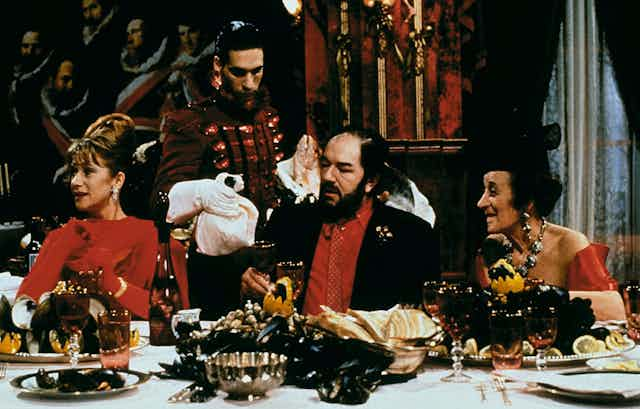Let’s get one thing out of the way from the start: I have neither read nor seen any of the Harry Potter stuff. Others may disagree, but I do not consider this a loss.
So it strikes me as a bit of shame that so many people, especially younger audiences, are probably more familiar with the late Michael’s Gambon’s role as Dumbledore in the Potter films than any of his other work.
They may be unaware that Gambon was a highly regarded theatre actor, then an award-winning TV favourite, then an art-house film star, before he became a Hollywood celebrity and national treasure. He developed a varied and acclaimed acting biography spanning five decades at least.
Of all his output, one particularly fascinating feature film that most deserves to be watched by new audiences is Peter Greenaway’s The Cook, The Thief, His Wife and Her Lover (1989).
Gambon plays Albert Spica, a gangster with working class origins who now sits at the top of London’s organised crime food chain. Much of the film takes place in Le Hollandais, an upper-class restaurant where Spica, his gang and his wife, Georgina (played by Helen Mirren), dine every night. The opening scene involves Spica exhibiting cruel, sadistic tendencies toward a debtor – I’ll spare you the unpleasant details.
Gambon is truly immersed in the character of Spica, wholeheartedly embracing the character’s cruelty, anger and in doing so he truly embodies Spica’s power – a far cry from the soft spoken and kind-natured Dumbledore (I’m told).
A violent man realised
The plot centres around an affair Spica’s wife Georgina begins with a regular at Le Hollandais, the gentle bookseller Michael. Between courses, the couple engage in sex in less public parts of the restaurant.
Spica, of course, begins to suspect his wife’s infidelity. From there, things become more violent and veer into the barbaric and perhaps obscene.
The Cook, The Thief, His Wife and Her Lover is a graphically violent work of art-house cinema. There are a few things that make this film unusual, distinctive and layered, not only in terms of its look (colour schemes, set and costume design, cinematography) but also its overarching message.
The Cook, The Thief, His Wife and Her Lover is about human relationships but also touches on the importance of food in our culture. Consumption is important, characters are consumed by anger, by love, by lust. Set in a restaurant, food plays a central role and the boundaries of it are played with to extreme and uncomfortable ways.
In a very different way, the film is also about how these characters are locked into structures linked with society, politics, culture and more.
At its heart, however, this is a film about power, greed and revenge. Holding this all together are the performances of the actors under the vision and direction of Greenaway.
I could write more about the various characters (and actors, including Ciaran Hinds, Tim Roth, for example), but it is Michael Gambon’s performance that functions as an anchor. This is not to say Gambon is a better actor than anyone else in the film, but he’s certainly the most interesting, even as what usually constitutes the ordinariness of cinematic villainy.
What Michael Gambon so brilliantly encapsulates is desire and hunger. No accident, given the salience of food in this film. But it goes beyond that, with every look, word, gesture and movement, Gambon epitomises an unhealthy and extreme obsession with control, order and obedience.
Gambon is genuinely disturbing and his performance sits among the brilliance of actors who have conveyed such villains as Nurse Ratched in One Flew Over the Cuckoo’s Nest, Annie Wilkes in Misery or different versions of Hannibal Lecter (Brian Cox’s is better than Anthony Hopkins’, in my opinion). In Albert Spica, there is something different, however.
Sure, Spica is larger than life – arguably a cliché in some respects – but it’s a controlled, purposeful and convincing performance that does more than enough to demonstrate Gambon’s skill, attention to craft and the space he leaves for his fellow players.
In turn, and to my mind, in order to elevate acting to that kind of level, there has to be a deep undercurrent of human empathy. Of course, I never met Michael Gambon, but I imagine those who knew him and worked with him would confirm that.

Looking for something good? Cut through the noise with a carefully curated selection of the latest releases, live events and exhibitions, straight to your inbox every fortnight, on Fridays. Sign up here.

